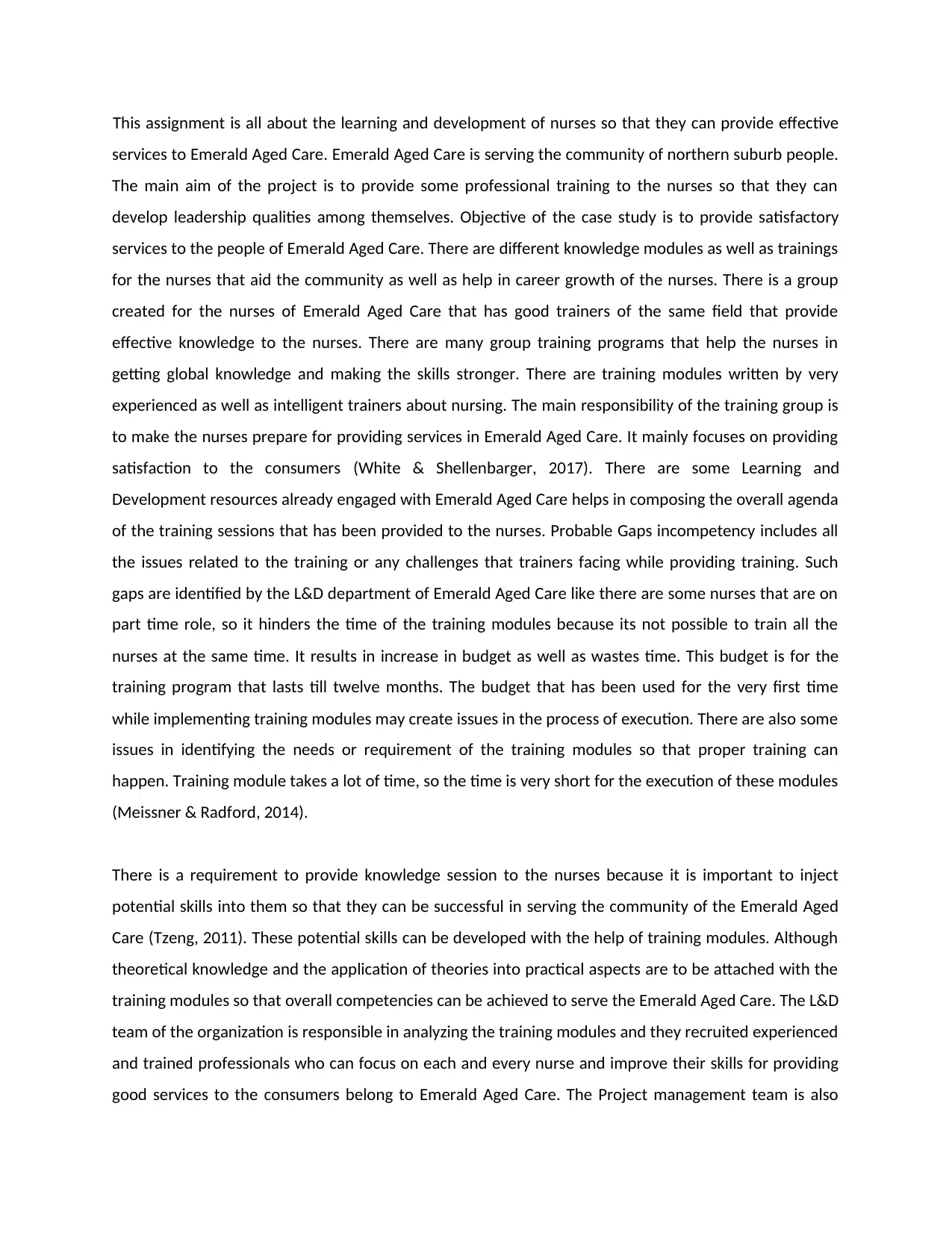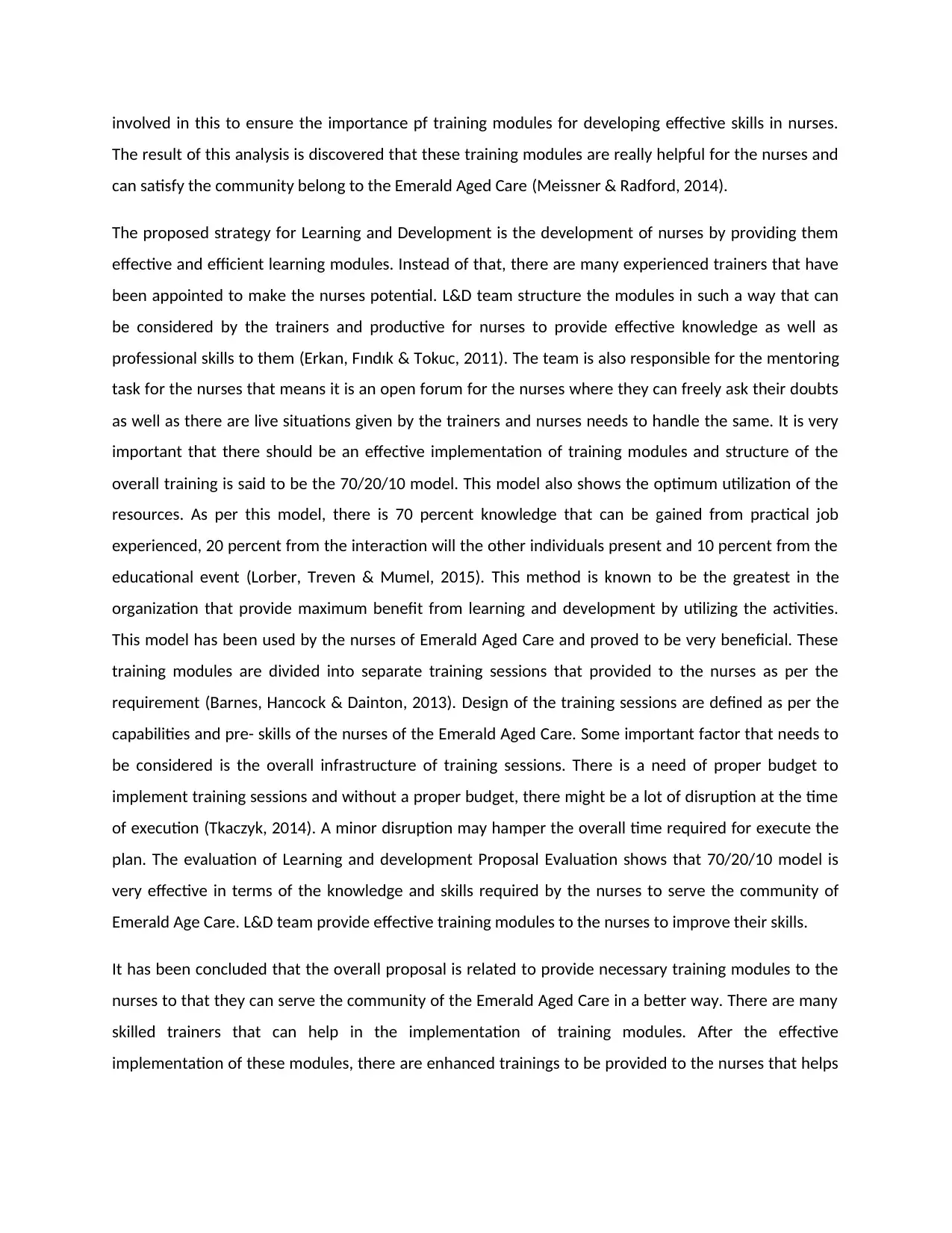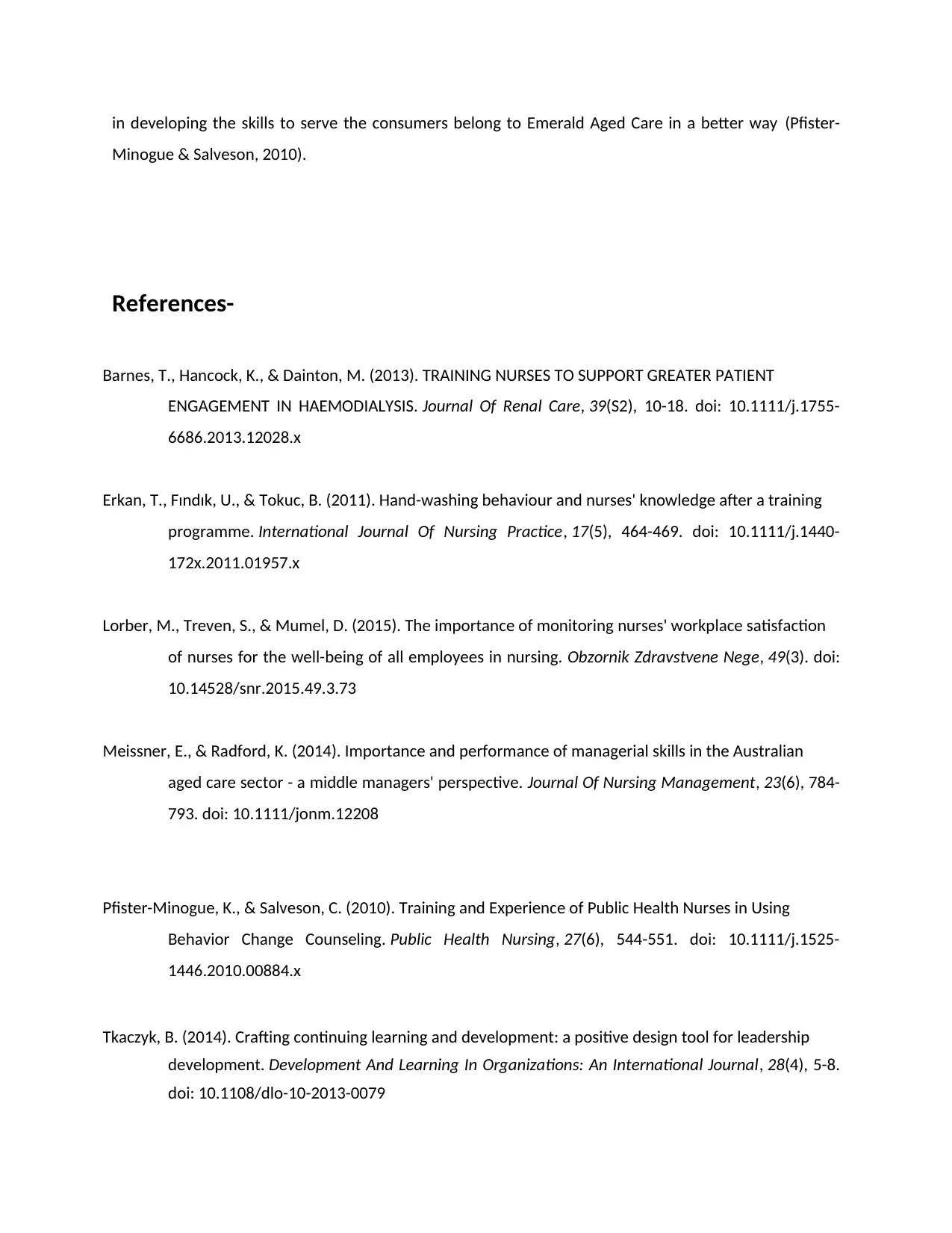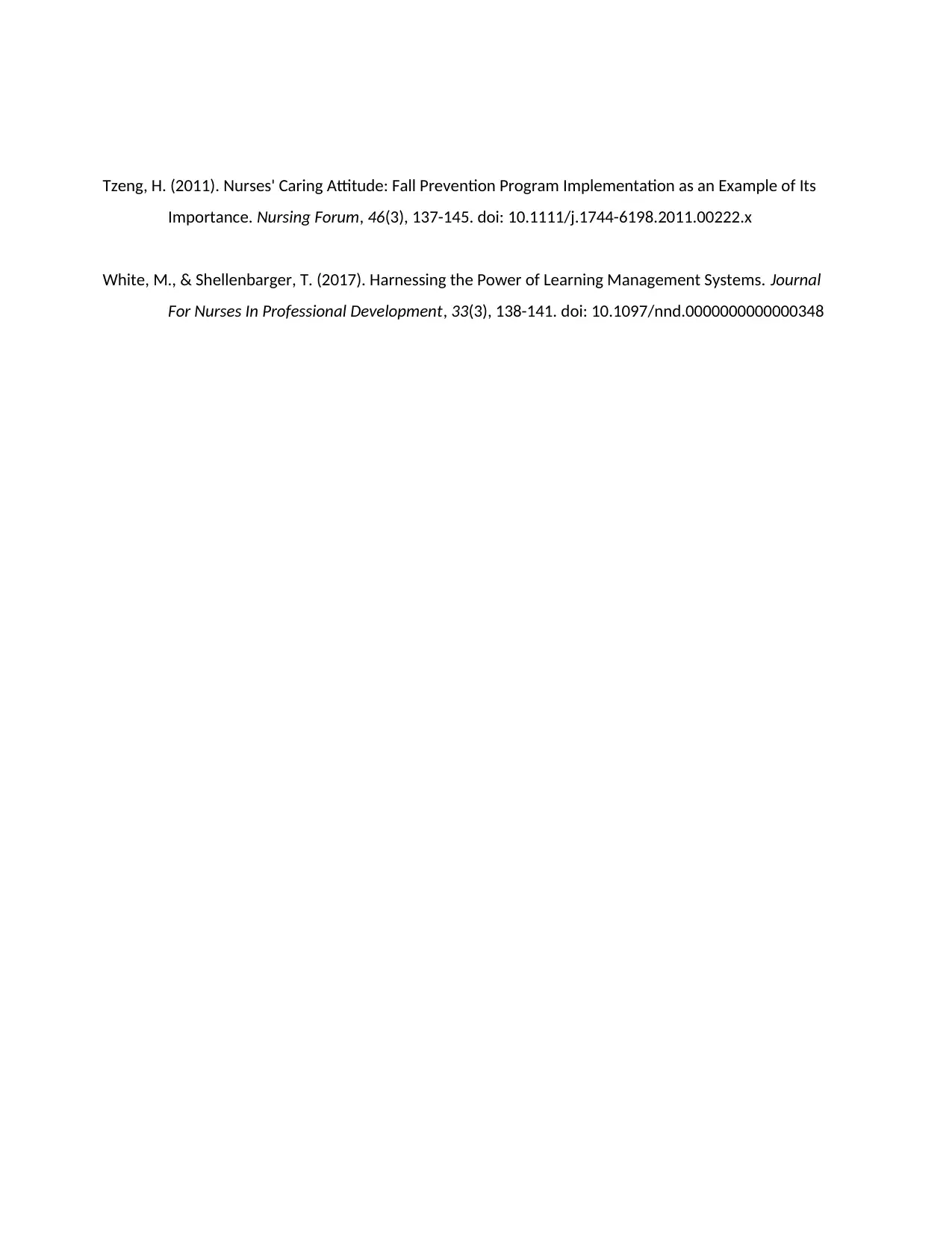MGT5DPP - Developing People: Nurse Training at Emerald Aged Care
VerifiedAdded on 2022/11/17
|4
|1448
|377
Report
AI Summary
This report focuses on the learning and development initiatives for nurses at Emerald Aged Care, a premium aged care community. The primary objective is to provide professional training to nurses, fostering leadership qualities and improving service quality for residents. The report outlines training modules, identifies competency gaps, and proposes strategies aligned with the 70/20/10 model for effective knowledge and skill development. The Learning and Development team is responsible for analyzing training modules, mentoring nurses, and ensuring the implementation of effective training programs. The report emphasizes the importance of practical experience, interaction, and educational events in the training process. The proposed strategy involves experienced trainers, mentoring programs, and a structured approach to training sessions based on the nurses' capabilities. Evaluation of the proposal highlights the effectiveness of the 70/20/10 model and concludes that the training modules help nurses provide better services to the Emerald Aged Care community.

This assignment is all about the learning and development of nurses so that they can provide effective
services to Emerald Aged Care. Emerald Aged Care is serving the community of northern suburb people.
The main aim of the project is to provide some professional training to the nurses so that they can
develop leadership qualities among themselves. Objective of the case study is to provide satisfactory
services to the people of Emerald Aged Care. There are different knowledge modules as well as trainings
for the nurses that aid the community as well as help in career growth of the nurses. There is a group
created for the nurses of Emerald Aged Care that has good trainers of the same field that provide
effective knowledge to the nurses. There are many group training programs that help the nurses in
getting global knowledge and making the skills stronger. There are training modules written by very
experienced as well as intelligent trainers about nursing. The main responsibility of the training group is
to make the nurses prepare for providing services in Emerald Aged Care. It mainly focuses on providing
satisfaction to the consumers (White & Shellenbarger, 2017). There are some Learning and
Development resources already engaged with Emerald Aged Care helps in composing the overall agenda
of the training sessions that has been provided to the nurses. Probable Gaps incompetency includes all
the issues related to the training or any challenges that trainers facing while providing training. Such
gaps are identified by the L&D department of Emerald Aged Care like there are some nurses that are on
part time role, so it hinders the time of the training modules because its not possible to train all the
nurses at the same time. It results in increase in budget as well as wastes time. This budget is for the
training program that lasts till twelve months. The budget that has been used for the very first time
while implementing training modules may create issues in the process of execution. There are also some
issues in identifying the needs or requirement of the training modules so that proper training can
happen. Training module takes a lot of time, so the time is very short for the execution of these modules
(Meissner & Radford, 2014).
There is a requirement to provide knowledge session to the nurses because it is important to inject
potential skills into them so that they can be successful in serving the community of the Emerald Aged
Care (Tzeng, 2011). These potential skills can be developed with the help of training modules. Although
theoretical knowledge and the application of theories into practical aspects are to be attached with the
training modules so that overall competencies can be achieved to serve the Emerald Aged Care. The L&D
team of the organization is responsible in analyzing the training modules and they recruited experienced
and trained professionals who can focus on each and every nurse and improve their skills for providing
good services to the consumers belong to Emerald Aged Care. The Project management team is also
services to Emerald Aged Care. Emerald Aged Care is serving the community of northern suburb people.
The main aim of the project is to provide some professional training to the nurses so that they can
develop leadership qualities among themselves. Objective of the case study is to provide satisfactory
services to the people of Emerald Aged Care. There are different knowledge modules as well as trainings
for the nurses that aid the community as well as help in career growth of the nurses. There is a group
created for the nurses of Emerald Aged Care that has good trainers of the same field that provide
effective knowledge to the nurses. There are many group training programs that help the nurses in
getting global knowledge and making the skills stronger. There are training modules written by very
experienced as well as intelligent trainers about nursing. The main responsibility of the training group is
to make the nurses prepare for providing services in Emerald Aged Care. It mainly focuses on providing
satisfaction to the consumers (White & Shellenbarger, 2017). There are some Learning and
Development resources already engaged with Emerald Aged Care helps in composing the overall agenda
of the training sessions that has been provided to the nurses. Probable Gaps incompetency includes all
the issues related to the training or any challenges that trainers facing while providing training. Such
gaps are identified by the L&D department of Emerald Aged Care like there are some nurses that are on
part time role, so it hinders the time of the training modules because its not possible to train all the
nurses at the same time. It results in increase in budget as well as wastes time. This budget is for the
training program that lasts till twelve months. The budget that has been used for the very first time
while implementing training modules may create issues in the process of execution. There are also some
issues in identifying the needs or requirement of the training modules so that proper training can
happen. Training module takes a lot of time, so the time is very short for the execution of these modules
(Meissner & Radford, 2014).
There is a requirement to provide knowledge session to the nurses because it is important to inject
potential skills into them so that they can be successful in serving the community of the Emerald Aged
Care (Tzeng, 2011). These potential skills can be developed with the help of training modules. Although
theoretical knowledge and the application of theories into practical aspects are to be attached with the
training modules so that overall competencies can be achieved to serve the Emerald Aged Care. The L&D
team of the organization is responsible in analyzing the training modules and they recruited experienced
and trained professionals who can focus on each and every nurse and improve their skills for providing
good services to the consumers belong to Emerald Aged Care. The Project management team is also
Paraphrase This Document
Need a fresh take? Get an instant paraphrase of this document with our AI Paraphraser

involved in this to ensure the importance pf training modules for developing effective skills in nurses.
The result of this analysis is discovered that these training modules are really helpful for the nurses and
can satisfy the community belong to the Emerald Aged Care (Meissner & Radford, 2014).
The proposed strategy for Learning and Development is the development of nurses by providing them
effective and efficient learning modules. Instead of that, there are many experienced trainers that have
been appointed to make the nurses potential. L&D team structure the modules in such a way that can
be considered by the trainers and productive for nurses to provide effective knowledge as well as
professional skills to them (Erkan, Fındık & Tokuc, 2011). The team is also responsible for the mentoring
task for the nurses that means it is an open forum for the nurses where they can freely ask their doubts
as well as there are live situations given by the trainers and nurses needs to handle the same. It is very
important that there should be an effective implementation of training modules and structure of the
overall training is said to be the 70/20/10 model. This model also shows the optimum utilization of the
resources. As per this model, there is 70 percent knowledge that can be gained from practical job
experienced, 20 percent from the interaction will the other individuals present and 10 percent from the
educational event (Lorber, Treven & Mumel, 2015). This method is known to be the greatest in the
organization that provide maximum benefit from learning and development by utilizing the activities.
This model has been used by the nurses of Emerald Aged Care and proved to be very beneficial. These
training modules are divided into separate training sessions that provided to the nurses as per the
requirement (Barnes, Hancock & Dainton, 2013). Design of the training sessions are defined as per the
capabilities and pre- skills of the nurses of the Emerald Aged Care. Some important factor that needs to
be considered is the overall infrastructure of training sessions. There is a need of proper budget to
implement training sessions and without a proper budget, there might be a lot of disruption at the time
of execution (Tkaczyk, 2014). A minor disruption may hamper the overall time required for execute the
plan. The evaluation of Learning and development Proposal Evaluation shows that 70/20/10 model is
very effective in terms of the knowledge and skills required by the nurses to serve the community of
Emerald Age Care. L&D team provide effective training modules to the nurses to improve their skills.
It has been concluded that the overall proposal is related to provide necessary training modules to the
nurses to that they can serve the community of the Emerald Aged Care in a better way. There are many
skilled trainers that can help in the implementation of training modules. After the effective
implementation of these modules, there are enhanced trainings to be provided to the nurses that helps
The result of this analysis is discovered that these training modules are really helpful for the nurses and
can satisfy the community belong to the Emerald Aged Care (Meissner & Radford, 2014).
The proposed strategy for Learning and Development is the development of nurses by providing them
effective and efficient learning modules. Instead of that, there are many experienced trainers that have
been appointed to make the nurses potential. L&D team structure the modules in such a way that can
be considered by the trainers and productive for nurses to provide effective knowledge as well as
professional skills to them (Erkan, Fındık & Tokuc, 2011). The team is also responsible for the mentoring
task for the nurses that means it is an open forum for the nurses where they can freely ask their doubts
as well as there are live situations given by the trainers and nurses needs to handle the same. It is very
important that there should be an effective implementation of training modules and structure of the
overall training is said to be the 70/20/10 model. This model also shows the optimum utilization of the
resources. As per this model, there is 70 percent knowledge that can be gained from practical job
experienced, 20 percent from the interaction will the other individuals present and 10 percent from the
educational event (Lorber, Treven & Mumel, 2015). This method is known to be the greatest in the
organization that provide maximum benefit from learning and development by utilizing the activities.
This model has been used by the nurses of Emerald Aged Care and proved to be very beneficial. These
training modules are divided into separate training sessions that provided to the nurses as per the
requirement (Barnes, Hancock & Dainton, 2013). Design of the training sessions are defined as per the
capabilities and pre- skills of the nurses of the Emerald Aged Care. Some important factor that needs to
be considered is the overall infrastructure of training sessions. There is a need of proper budget to
implement training sessions and without a proper budget, there might be a lot of disruption at the time
of execution (Tkaczyk, 2014). A minor disruption may hamper the overall time required for execute the
plan. The evaluation of Learning and development Proposal Evaluation shows that 70/20/10 model is
very effective in terms of the knowledge and skills required by the nurses to serve the community of
Emerald Age Care. L&D team provide effective training modules to the nurses to improve their skills.
It has been concluded that the overall proposal is related to provide necessary training modules to the
nurses to that they can serve the community of the Emerald Aged Care in a better way. There are many
skilled trainers that can help in the implementation of training modules. After the effective
implementation of these modules, there are enhanced trainings to be provided to the nurses that helps

in developing the skills to serve the consumers belong to Emerald Aged Care in a better way (Pfister-
Minogue & Salveson, 2010).
References-
Barnes, T., Hancock, K., & Dainton, M. (2013). TRAINING NURSES TO SUPPORT GREATER PATIENT
ENGAGEMENT IN HAEMODIALYSIS. Journal Of Renal Care, 39(S2), 10-18. doi: 10.1111/j.1755-
6686.2013.12028.x
Erkan, T., Fındık, U., & Tokuc, B. (2011). Hand-washing behaviour and nurses' knowledge after a training
programme. International Journal Of Nursing Practice, 17(5), 464-469. doi: 10.1111/j.1440-
172x.2011.01957.x
Lorber, M., Treven, S., & Mumel, D. (2015). The importance of monitoring nurses' workplace satisfaction
of nurses for the well-being of all employees in nursing. Obzornik Zdravstvene Nege, 49(3). doi:
10.14528/snr.2015.49.3.73
Meissner, E., & Radford, K. (2014). Importance and performance of managerial skills in the Australian
aged care sector - a middle managers' perspective. Journal Of Nursing Management, 23(6), 784-
793. doi: 10.1111/jonm.12208
Pfister-Minogue, K., & Salveson, C. (2010). Training and Experience of Public Health Nurses in Using
Behavior Change Counseling. Public Health Nursing, 27(6), 544-551. doi: 10.1111/j.1525-
1446.2010.00884.x
Tkaczyk, B. (2014). Crafting continuing learning and development: a positive design tool for leadership
development. Development And Learning In Organizations: An International Journal, 28(4), 5-8.
doi: 10.1108/dlo-10-2013-0079
Minogue & Salveson, 2010).
References-
Barnes, T., Hancock, K., & Dainton, M. (2013). TRAINING NURSES TO SUPPORT GREATER PATIENT
ENGAGEMENT IN HAEMODIALYSIS. Journal Of Renal Care, 39(S2), 10-18. doi: 10.1111/j.1755-
6686.2013.12028.x
Erkan, T., Fındık, U., & Tokuc, B. (2011). Hand-washing behaviour and nurses' knowledge after a training
programme. International Journal Of Nursing Practice, 17(5), 464-469. doi: 10.1111/j.1440-
172x.2011.01957.x
Lorber, M., Treven, S., & Mumel, D. (2015). The importance of monitoring nurses' workplace satisfaction
of nurses for the well-being of all employees in nursing. Obzornik Zdravstvene Nege, 49(3). doi:
10.14528/snr.2015.49.3.73
Meissner, E., & Radford, K. (2014). Importance and performance of managerial skills in the Australian
aged care sector - a middle managers' perspective. Journal Of Nursing Management, 23(6), 784-
793. doi: 10.1111/jonm.12208
Pfister-Minogue, K., & Salveson, C. (2010). Training and Experience of Public Health Nurses in Using
Behavior Change Counseling. Public Health Nursing, 27(6), 544-551. doi: 10.1111/j.1525-
1446.2010.00884.x
Tkaczyk, B. (2014). Crafting continuing learning and development: a positive design tool for leadership
development. Development And Learning In Organizations: An International Journal, 28(4), 5-8.
doi: 10.1108/dlo-10-2013-0079
⊘ This is a preview!⊘
Do you want full access?
Subscribe today to unlock all pages.

Trusted by 1+ million students worldwide

Tzeng, H. (2011). Nurses' Caring Attitude: Fall Prevention Program Implementation as an Example of Its
Importance. Nursing Forum, 46(3), 137-145. doi: 10.1111/j.1744-6198.2011.00222.x
White, M., & Shellenbarger, T. (2017). Harnessing the Power of Learning Management Systems. Journal
For Nurses In Professional Development, 33(3), 138-141. doi: 10.1097/nnd.0000000000000348
Importance. Nursing Forum, 46(3), 137-145. doi: 10.1111/j.1744-6198.2011.00222.x
White, M., & Shellenbarger, T. (2017). Harnessing the Power of Learning Management Systems. Journal
For Nurses In Professional Development, 33(3), 138-141. doi: 10.1097/nnd.0000000000000348
1 out of 4
Related Documents
Your All-in-One AI-Powered Toolkit for Academic Success.
+13062052269
info@desklib.com
Available 24*7 on WhatsApp / Email
![[object Object]](/_next/static/media/star-bottom.7253800d.svg)
Unlock your academic potential
Copyright © 2020–2025 A2Z Services. All Rights Reserved. Developed and managed by ZUCOL.





